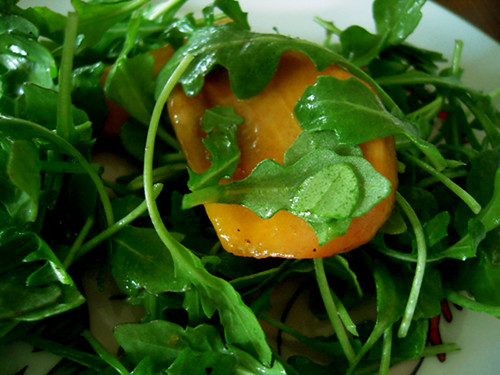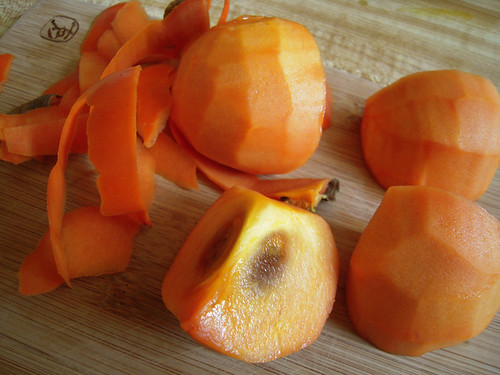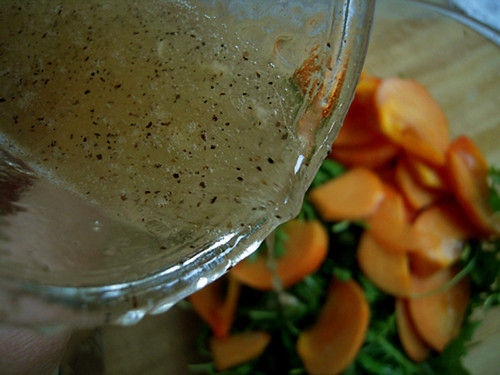
One thing California and Japan have in common is the abundance of bright orange
Fuyu persimmons when November hits. Persimmon or
kaki, in Japanese, are best eaten uncooked and must be peeled. The most common way to eat them in Japan is for dessert, perhaps alongside a branch of a few very plump
kyoho grapes.
 Kaki
Kaki peeled

The thought of incorporating
kaki into my meals never occurred to me until I was served salads with
kaki at both the
Chez Panisse Cafe and
Pizzaiolo during the first week of November. It was definitely creative and very Californian and I shamelessly adapt it here for Japanify this week.
SALAD
2 large handfuls of the freshest, youngest arugula you can find
1 Fuyu persimmon sliced
DRESSING*
Recipe makes much more than you need, keeps for a long time
1/3 cup vegetable oil
1/3 cup rice vinegar (or white wine vinegar)
2 cloves garlic, minced
1 teaspoon sugar
1/2 teaspoon salt
1 pinch ground black pepper
*use 2 tablespoons of dressing for the salad size above
METHOD
1. Wash and spin arugula.
2. Peel and cut
kaki into quarters. Slice thin.
3. Add all of the dressing ingredients into a jar, bottle or container with lid. Shake vigorously.
4. Drizzle dressing onto salad.
5. Toss well and serve.

Not only does this salad showcase the bounty of fall, it is also SO easy! You can add avocado if you want, but the salad is best kept simple with the contrast of the sweet
kaki and the spicy arugula taking center stage.

 One thing California and Japan have in common is the abundance of bright orange Fuyu persimmons when November hits. Persimmon or kaki, in Japanese, are best eaten uncooked and must be peeled. The most common way to eat them in Japan is for dessert, perhaps alongside a branch of a few very plump kyoho grapes.
One thing California and Japan have in common is the abundance of bright orange Fuyu persimmons when November hits. Persimmon or kaki, in Japanese, are best eaten uncooked and must be peeled. The most common way to eat them in Japan is for dessert, perhaps alongside a branch of a few very plump kyoho grapes.
 Kaki peeled
Kaki peeled
 The thought of incorporating kaki into my meals never occurred to me until I was served salads with kaki at both the Chez Panisse Cafe and Pizzaiolo during the first week of November. It was definitely creative and very Californian and I shamelessly adapt it here for Japanify this week.
SALAD
2 large handfuls of the freshest, youngest arugula you can find
1 Fuyu persimmon sliced
DRESSING*
Recipe makes much more than you need, keeps for a long time
1/3 cup vegetable oil
1/3 cup rice vinegar (or white wine vinegar)
2 cloves garlic, minced
1 teaspoon sugar
1/2 teaspoon salt
1 pinch ground black pepper
*use 2 tablespoons of dressing for the salad size above
METHOD
1. Wash and spin arugula.
2. Peel and cut kaki into quarters. Slice thin.
3. Add all of the dressing ingredients into a jar, bottle or container with lid. Shake vigorously.
4. Drizzle dressing onto salad.
5. Toss well and serve.
The thought of incorporating kaki into my meals never occurred to me until I was served salads with kaki at both the Chez Panisse Cafe and Pizzaiolo during the first week of November. It was definitely creative and very Californian and I shamelessly adapt it here for Japanify this week.
SALAD
2 large handfuls of the freshest, youngest arugula you can find
1 Fuyu persimmon sliced
DRESSING*
Recipe makes much more than you need, keeps for a long time
1/3 cup vegetable oil
1/3 cup rice vinegar (or white wine vinegar)
2 cloves garlic, minced
1 teaspoon sugar
1/2 teaspoon salt
1 pinch ground black pepper
*use 2 tablespoons of dressing for the salad size above
METHOD
1. Wash and spin arugula.
2. Peel and cut kaki into quarters. Slice thin.
3. Add all of the dressing ingredients into a jar, bottle or container with lid. Shake vigorously.
4. Drizzle dressing onto salad.
5. Toss well and serve.
 Not only does this salad showcase the bounty of fall, it is also SO easy! You can add avocado if you want, but the salad is best kept simple with the contrast of the sweet kaki and the spicy arugula taking center stage.
Not only does this salad showcase the bounty of fall, it is also SO easy! You can add avocado if you want, but the salad is best kept simple with the contrast of the sweet kaki and the spicy arugula taking center stage.





Comments (9)
Many persimmons available here in the US are miraculously all sweet. But when you hit very bitter/sour ones, soak newspaper in shochu, place it on the bottom of ziploc, place persimmons upside down, and seal them, and wait for a couple of days.
Yamahomo! Wow, that sounds delicious. How does it taste? Is it sticky or dried-out or just ripened? What a great trick.
I have found that they ripen of the tree. Sometimes I buy kaki that are less than bright orange – even yellowish but they turn orange pretty quickly in a few days, especially when I store them with some other fall fruit nearby.
No it’s just how you get rid of bitterness. It does get more ripen since you will have to wait for a couple of days. In Japan where we have kaki tree in the backyard, we harvest them before getting eaten by birds, then do the shochu method (as i said, it’s not soaked in shochu, it’s stored in shochu soaked newspaper). I’ve heard about storing them with other fall fruit as well, but it apparently takes more time.
Booze is always a quick fix for everything.
Yamahomo: I need to get my drank on soon with you guys.
Yoko, I wonder if Kaki is available in Denmark, it must have a Scandinavian name… When using Google Translate English > Danish, it says “persimmon = kaki”… hmm…
Yamahomo
Oh, ok, I get it – that it’s a ripening technique.
Anders
I dunno, let me know if you do find kaki in Denmark. You might have to go to an “ethnic” grocer.
ive been making this all week! a coworker gave me a bunch :D benefits from the addition of avocado and grape tomatoes :D :D
Yeay! I am so glad you are making this. Isn’t it the best?! I am addicted. I make it almost every day. Yes, I really love it with avocado too. I will try adding mini tomatoes some time.
I love kaki, though I didn’t use to growing up. I love them crisp and firm like this, as well as scooped out of its flesh once it’s super-duper-ripe (squishy sweet goodness!). I was amused in Italy when I learned they use the name “kaki (cachi)” - since the original seeds came from giappone- and adapted it, referring to one kaki as a “caco” (masculine plurals end in “i”, so they just took “kaki” and singularized it in the masculine form). I think it’s so cute— un caco!
At the restaurant I’m at, we have a kaki-“fruit tomato” (do they have them there?)-cilantro-shallot dressing for the carpaccio salad. It works!